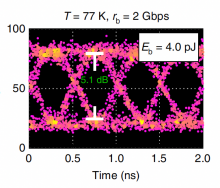
Superconducting circuits can operate at higher energy efficiencies than their room-temperature counterparts and have the potential
to enable large-scale control and readout of quantum computers. However, the required interface with room-temperature
electronics creates difficulties in scaling up such cryogenic systems. One option is to use optical fibres as a medium in conjunction
with fast optical modulators that can be efficiently driven by electrical signals at low temperatures. However, as superconducting
circuits are current operated with low impedances, they interface poorly with conventional electro-optical modulators.
Here we report an integrated current-driven modulator that is based on the magneto-optic effect and can operate at temperatures
as low as 4 K. The device combines a magneto-optic garnet crystal with a silicon waveguide resonator and integrates an
electromagnet to modulate the refractive index of the garnet. The modulator offers data rates of up to 2 Gbps with an energy
consumption below 4 pJ per bit of transferred information, which could be reduced to less than 50 fJ per bit by replacing dissipative
electrodes with superconductors and optimizing the geometric parameters.